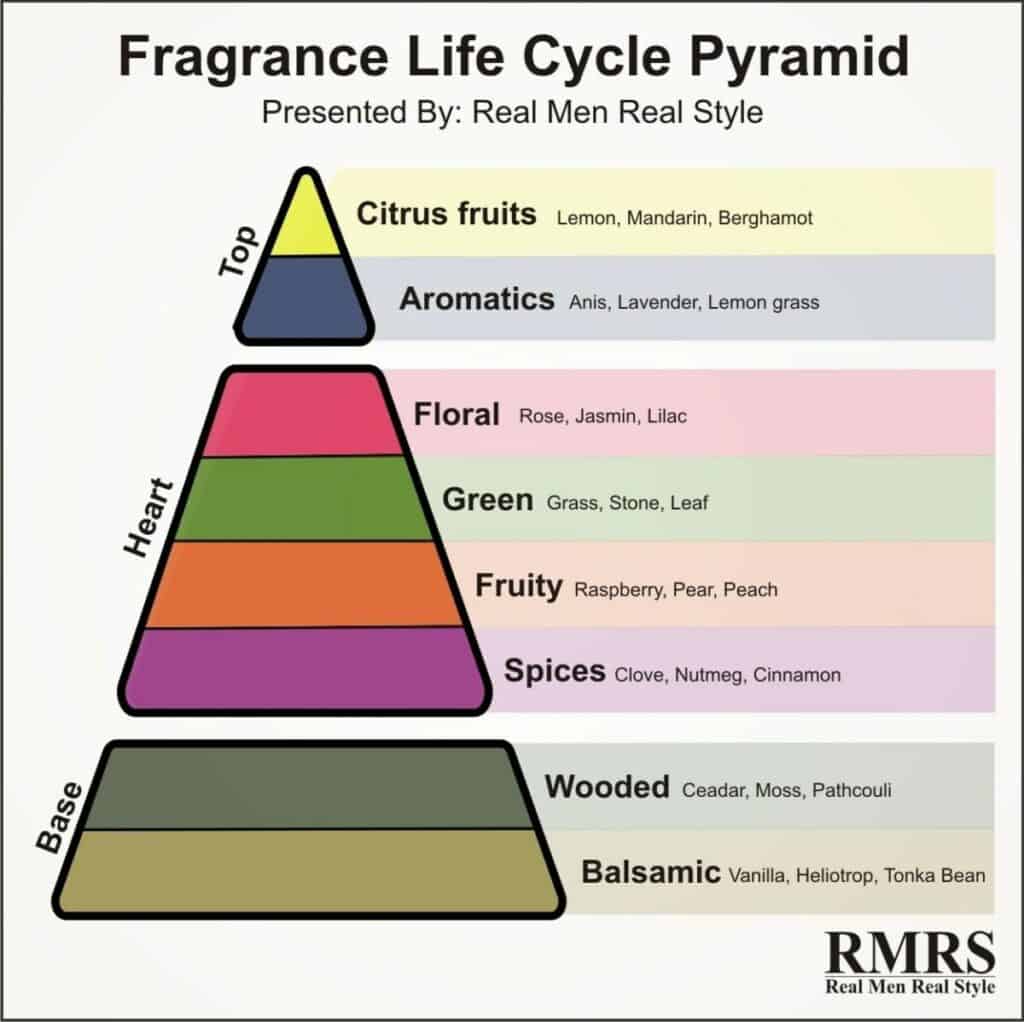Perfumes, much like music or art, can be a deeply personal and emotional experience, and being able to articulate those feelings can enhance your appreciation of this captivating olfactory universe.
Mastering the language of fragrance not only allows you to communicate your preferences and impressions effectively but also opens the doors to discovering new scents and broadening your olfactory vocabulary. It is an integral part of your journey in the world of perfumery, aiding you in appreciating the art and science that goes into creating the scents that stir your senses and evoke a myriad of emotions.
Fragrance is a language without words.
By the end of this article, you will be empowered with the knowledge and skills to explore the enchanting world of fragrances in a much more nuanced and profound way. So sit back, relax, and let’s embark on this fragrant journey together!

What Are the Elements of Fragrance?
Describing a fragrance can seem like a daunting task, given the complexity of scents and the unique sensory experience that each one provides. However, with a basic understanding of the key components of fragrances, it becomes a much simpler task. These components include notes, accords, and families. Let’s delve deeper into these elements.
Notes
Fragrance is like a symphony, where each note or ingredient contributes to a unique scent. These notes make a fragrance complex and characterful.
These ‘notes’ are divided into three types: top, middle (or heart), and base notes. Each plays a specific role in shaping the overall scent.

Image From RMRS
- Top Notes: These are the initial scents you perceive when you first apply a fragrance. They are often light, fresh, and evaporate quickly. Common examples include citrus scents like lemon, bergamot, and grapefruit.
- Middle Notes: Also known as heart notes, these make up the core of the fragrance. They start to emerge as the top notes dissipate and tend to be more balanced and well-rounded. Floral and fruity notes like rose, jasmine, and apple often play the role of middle notes.
- Base Notes: These are the last to develop and linger the longest. Base notes are often rich, deep scents that provide depth and longevity to the fragrance. Examples include woody notes like cedar and sandalwood, or spicy notes like vanilla and amber.
Understanding these notes will help you better describe a fragrance. For instance, instead of simply saying a perfume smells ‘nice’, you can articulate that it has ‘a fresh citrusy top note, a heart of romantic rose, and a warm vanilla base’.
Common Fragrance Notes
Let’s delve deeper into the world of fragrances and explore some of the most common notes you might come across:
- Citrus Notes: Think of the crisp and tangy scent of lemons, oranges, and grapefruits. Citrus notes are bright, refreshing, and often used as top notes.
- Floral Notes: This category encompasses the sweet and romantic scents of flowers like roses, jasmine, and lilies. Floral notes are usually used as heart notes.
- Woody Notes: These bring to mind the scent of a forest or a freshly cut log. Woody notes such as cedar, pine, and sandalwood provide depth and can be found as base notes.
- Spicy Notes: Spices like cinnamon, clove, and vanilla offer warm, exotic scents that often act as base notes.
Women are more likely to purchase floral and fruity scents, while men prefer woody and spicy fragrances. Learning to identify these notes can greatly enhance your ability to describe fragrances. Go ahead, give your senses a treat, and dive into the wonderful world of fragrances!
Accords
When describing a fragrance, one of the fundamental concepts you need to grasp is that of ‘accords’. Accords can best be described as a harmonious blend of different notes which together, produce a unique scent. This synergy of scents is what gives a fragrance its distinctive character. Think of accords as the symphony of a fragrance, where different notes come together to perform a melodious composition.
Fragrance accords are quite similar to the chords in music; a combination of notes played simultaneously to create a harmonious sound. Similarly, accords are a balanced combination of different fragrance notes that create a unique, harmonious scent narrative.
Examples of Popular Accords
There are numerous types of accords used in the world in perfumery. Some of the most popular ones include:
- Oriental Accord: This accord is characterized by rich and warm notes such as amber, vanilla, and resin. Oriental accord is often associated with exotic, mysterious, and sensual fragrances.
- Chypre Accord: Originating from the French word for Cyprus, chypre accords combine woody-mossy notes with elements of citrus and patchouli. This results in a sophisticated, elegant, and timeless fragrance.
- Fougère Accord: Derived from the French word for fern, fougère accords are built on a base of lavender, oakmoss, and coumarin. They are typically found in fresh and aromatic fragrances, conveying a sense of natural, outdoorsy vibrancy.
Learn about accords to enhance your scent description. It’s the mix of notes that makes a scent interesting.
Scents are fascinating for their depth and emotion. Immerse yourself, let the smells surround you, and use your knowledge to describe them.
Families
In the perfume world, fragrances are often categorized into ‘families‘ based on their dominant characteristics. Here are some common fragrance families:
- Floral: These fragrances are dominated by scents of one or more types of flowers.
- Oriental: These are rich, spicy, and sensual, often containing notes like vanilla, cinnamon, and clove.
- Woody: These scents are warm and opulent, drawing largely from notes like sandalwood, cedar, and patchouli.
- Fresh: Comprising largely of citrus, green and aquatic notes, these fragrances are light, zesty, and uplifting.
Understanding these components is the first step in being able to describe a fragrance effectively. It’s like learning a new language – once you’ve grasped the basic vocabulary, you’re well on your way to becoming fluent!
How To Use Descriptive Words and Categories?
Describing a fragrance is an art that requires a sensitive nose, a rich vocabulary, and a vivid imagination. It’s an essential skill for anyone who wants to understand, appreciate, and communicate the beauty and complexity of perfumes. Here, we will break down the importance of using descriptive words and categories, provide some tips on how to choose them, and give some examples for different fragrances.
Why Use Descriptive Words and Categories?
One might question the need for such detailed descriptions. So, here’s why:
- Capturing the nuances and characteristics of a fragrance: Every fragrance is a unique blend of different notes, each with its own characteristics. To capture these nuances, we need to use descriptive words and categories that can convey the richness and complexity of the scent.
- Comparing and contrasting different fragrances: Descriptions also allow us to compare and contrast different fragrances. This is particularly useful when we are trying to find a new perfume that matches our taste and preference.
- Conveying personal opinion and impression: Lastly, descriptions are a way to express our personal opinion and impression of a fragrance. They allow us to share our experience and preference with others, creating a meaningful dialogue about fragrances.
Remember, the beauty of a fragrance is not just in its scent, but also in the words that describe it.
Choosing Descriptive Words and Categories
Choosing the right words and categories to describe a fragrance can be tricky. Here are a few tips to help you:
- Use sensory adjectives: These could be taste-based like sweet, sour, bitter, salty, or texture-based like smooth, rough, soft, hard.
- Use emotional adjectives: These could include emotions evoked by the fragrance such as happy, sad, angry, calm. The sense of smell is closely linked to memory and emotions, with certain scents able to trigger strong emotional responses.
- Use abstract adjectives: These could speak to the impression the fragrance gives off such as elegant, modern, classic.
- Use associative adjectives: These could describe who the fragrance might be perfect for, such as feminine, masculine, unisex.
- Use specific or general terms: These could describe the type of scent such as fruity, floral, gourmand, aquatic or the overall feel of the fragrance such as warm, cool, light, dark.
- Use positive or negative words: Depending on your preference and intention, you can use positive or negative words to describe a fragrance.
Examples of Descriptive Words and Categories for Different Fragrances
Now, let’s look at some examples:
| Fragrance | Description |
|---|---|
| Chanel No. 5 | A classic floral aldehyde fragrance with notes of rose, jasmine, ylang-ylang, aldehydes, sandalwood, and vanilla. It is elegant, sophisticated, timeless, and iconic. |
| Dior Sauvage | A modern fresh spicy fragrance with notes of bergamot, pepper, lavender, ambroxan, and vetiver. It is bold, masculine, adventurous, and charismatic. |
| Jo Malone English Pear & Freesia | A fruity floral fragrance with notes of pear, freesia, rose, patchouli, and amber. It is fresh, delicate, feminine, and cheerful. |
Understanding the Art of Telling a Perfume Story
A perfume story is a narrative or description designed to evoke the mood, atmosphere, inspiration, or theme of a fragrance. It’s more than a simple list of ingredients – it’s a journey into a world of senses, a path that leads us through meadows, forests, and bustling bazaars, all carried by the invisible waves of scent.
The Importance of a Perfume Story
Engaging your reader’s imagination and emotions with a perfume story is vital. It allows you to create a bond between the person and the fragrance, helping them express their personality and style. The power of scent is deeply tied to our emotions and memories, and a well-crafted perfume story can tap into that power.
Tips on How to Craft a Compelling Perfume Story
- Conjure up vivid imagery and sensory details.
- Utilize metaphors and similes to deepen understanding.
- Draw on personal anecdotes or memories for authenticity.
- Incorporate historical or cultural references for depth and context.
- Instill humor or irony to add a unique twist.
Remember, your perfume story should be as unique and captivating as the fragrance itself!
Examples of Perfume Stories
| Perfume | Description |
|---|---|
| Guerlain Shalimar | A legendary oriental fragrance with notes of bergamot, iris, vanilla, and opoponax. Inspired by the love story of Emperor Shah Jahan and his wife Mumtaz Mahal, who built the Taj Mahal as a symbol of their eternal devotion. It evokes the exoticism, sensuality, and mystery of the East. |
| Calvin Klein CK One | A revolutionary unisex fragrance with notes of bergamot, green tea, jasmine, musk, and amber. Inspired by the youth culture of the 90s, who challenged the norms and embraced diversity. It represents the freedom, individuality, and energy of a generation. |
| Marc Jacobs Daisy | A playful floral fragrance with notes of strawberry, violet, jasmine, vanilla, and musk. Inspired by the daisy flower, which symbolizes innocence, purity, and happiness. It captures the essence of a sunny day in a meadow full of flowers. |
Conclusion
In summary, being able to describe a fragrance effectively is an art that goes beyond merely identifying if a scent is pleasant or not. This skill involves understanding and articulating various elements such as notes, accords, families, and even perfume stories. It’s a journey that encompasses categorizing scents and using descriptive words to paint a vivid picture of the fragrance.
The benefits of this proficiency are immense. It not only amplifies your enjoyment and appreciation of perfumes but also enables you to share your passion and opinions with a wider audience. Furthermore, it opens up opportunities for you to discover novel scents and experiences.
Perfume is the art that makes memory speak.
As a next step, we encourage you to visit perfume shops or museums to experience different fragrances firsthand. Joining online or offline communities of perfume enthusiasts can also provide valuable insights and learning opportunities.
Remember, your olfactory journey is unique and highly personal. Enjoy every step of it.
